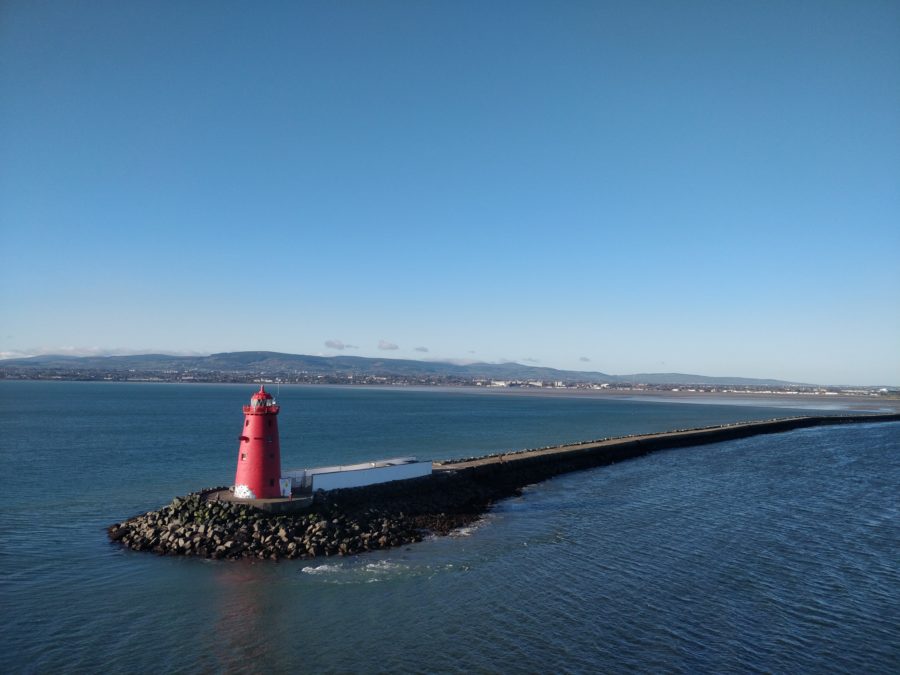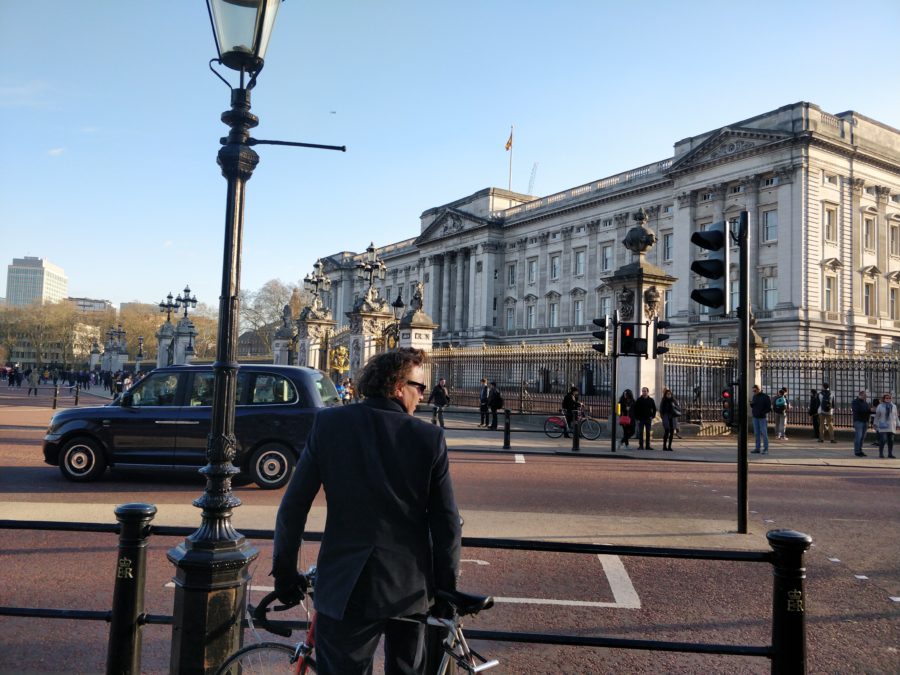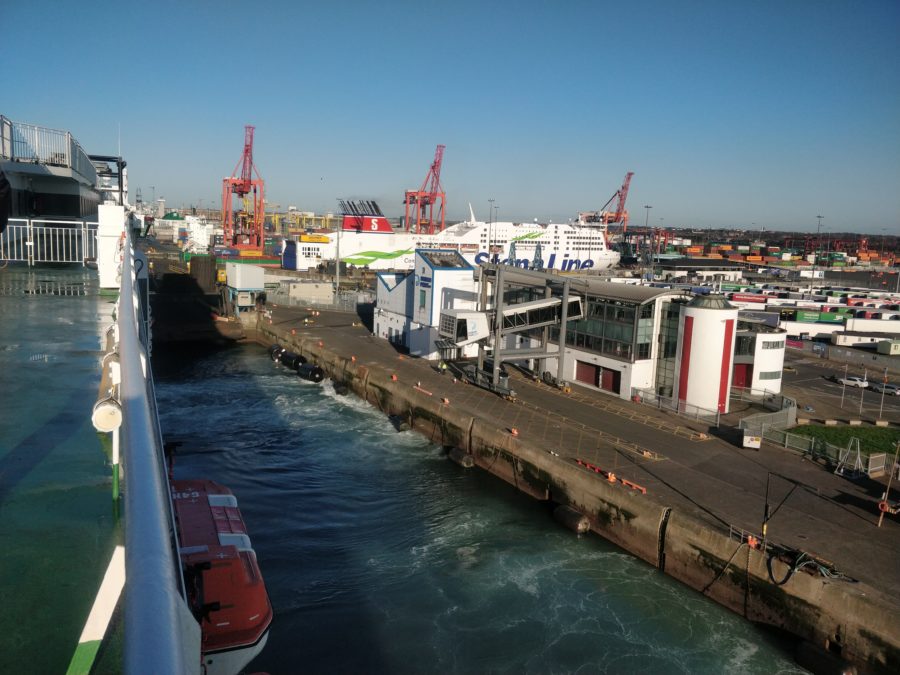Sail-Rail passage between Dublin and London currently takes about eight hours – but could be slashed to under four. The emergence of what the Swede’s call ‘flight shame’ in this era of Climate Change, may motivate many to look for alternatives on what is Europe’s busiest air corridor.
I – Outset
An era of climate challenge requires changes in all sectors. Among those calculated, air travel is reckoned to have one of the fastest-rising greenhouse gas emissions’ profiles – with each passenger trip disproportionately contributing to man-made climate change.[i] Accordingly, where an alternative mode is viable, it seems reasonable to consider, and indeed try this out.
For inhabitants of Ireland, it is noteworthy that the Dublin-London air corridor is the ninth busiest in the world, and the busiest in Europe, accounting for 15,000 flights per annum.[ii] According to ‘the Man in Seat 61’ website, a trip by plane from London to Dublin produces 174.8 kilograms of CO2 emissions per passenger.[iii]
This is not an exact science, nonetheless, with numerous passengers conveyed by Boeing 737s, which typically carry one-hundred-and-eighty passengers, a reasonable guesstimate is that this results in almost half-a-billion kilograms of CO2 emissions per annum. In contrast, as also noted by the Man in Seat 61, choosing to travel sail-rail rather than by air between the two cities brings a 71% reduction in emissions, or 46.8 kilograms of CO2 per passenger.
In a recent flight of fancy, I decided to take a trip to London with bicycle by boat and train. This journey involved a planned detour via Oxford, but these observations apply also to the direct London trip.
II – Preparation
Departure times are available on the British Rail website, along with those of the ferry operators. Both Irish Ferries and Stena Line sail from Dublin ferry port to Holyhead. Irish Ferries has two early morning crossings: the first, a slightly faster ferry leaves at 7.30am – having previously departed at 8.30am – while the second, slower ferry, leaves at 8.05am. The Stena Line ferry leaves at 8.10am, and is even slower. Passengers must check-in a half-hour before departure.
The journey time for the one-hundred-and-twenty-kilometre crossing is typically three-and-a-half hours – with the fastest currently operating taking two hours. Previously there was a faster ferry, which only took one hour forty minutes,[iv] travelling between Holyhead and Dun Laoghaire, where it met Dublin’s DART rail service. Alas this is no longer operating.
As with air travel, it is prudent to check ahead regarding weather conditions as ferry crossings can be affected, particularly the fast crossing, which may be cancelled in rough conditions; although it is extremely rare for the slower crossings to be held ashore.
Trains departing and arriving in Holyhead do not necessarily align with the arrivals and departures of ferries. However, the ferry departing Dublin at 7.30am docks at Holyhead and connects with a service train to London – requiring a change at Chester involving a twenty-minute layover (12.15pm to 12.35pm) – with scheduled downtown arrival at 2.38pm.
A number of differences are apparent with the experience of travelling by sail-rail, rather than by plane, on this route. An obvious drawback is the time involved; a minimum of almost eight hours – as opposed to approximately four for the equivalent by air. The journey is, nonetheless, generally less stressful, and has a lower environmental impact; nor are passengers exposed to the potentially hazardous atmosphere associated with airline travel.[v]
Moreover, as the price is a set at a flat rate of €53/£43, increasing by small increments depending on the distance from Holyhead, which can be booked via www.thetrainline.co.uk, or the Irish Ferries or Stena Line websites up until the last minute – or even at the port itself – this may compare favourably with the cost of an air ticket between the two cities, if booked only a day or so beforehand, especially during peak periods.
Sail-rail may thus suit a variety of people: not least families with young children; persons with heart or other health conditions; older people; and those happy to exchange more time for less stress.
Other differences in the journey experience which may attract prospective travellers include, an absence of weight restriction on passengers’ baggage, and, in general, lesser queues at passport controls.
While booking a sail-rail ticket is straightforward, making a bike reservation is complicated, when attempted from Ireland. In this case calling a helpline to ask an operator – seemingly unfamiliar with such a request – was required to book the bike on board the train. Contact then also had to be made with each of the train companies involved with each leg of the journey.
Ironically, rail privatisation in the U.K. has become a bureaucrat’s dream. For persons already in the U.K., sail-rail with a bicycle is far simpler, as bike tickets can be purchased along with the rail ticket itself at any station – although, in this instance, when travelling back to Dublin from Oxford, the process resulted in a ludicrous number of about ten tickets being produced to cover each leg of the journey.

III – Departing Dublin
Cycling to the ferry port from Dublin city centre could be more pleasant and safer. The 3.2 kilometre route to the ferry terminals from the Point Depot was approached via Alexandra Road – rather than Tolka Road, which is much busier. Neither have cycleways, and the surface along Alexandra Road is ridged concrete that is uneven and pot-holed.
There are also Iarnrod Eireann tracks along this route, which, alas, only convey freight rather than foot passengers – or indeed cyclists! Consequently, foot passengers generally rely on taxis or rare and relatively expensive buses – while cyclists must negotiate the Iarnrod Eireann rail tracks criss-crossing the road, as no cycle provision has been made.
Take great care if using these roads, as there are also frequently fast-moving large articulated lorries – of the kind notorious for blind spots, and disproportionately associated with fatalities of cyclists in Dublin in recent decades.[vi]
It is regrettable, but necessary to observe, that cyclists that consider themselves potentially more vulnerable – such as parents travelling with children – would be advised to travel by taxi along this section. Moreover, as the road is quite long and runs through industrial areas, walking is not advised.
Upon reaching the Dublin ferry terminal, cyclists must check in at the same desk as foot passengers. Rather than walking onto the boat with one’s bicycle, however, direction was given on this occasion to cross the road and cycle up the same ramp as that used by articulated lorries and cars – albeit empty at the time.
This adds a circuitous route of circa three hundred and fifty metres up a steep ramp, which should not pose any problems for more athletic sorts, but could be off-putting for more vulnerable cyclists. If this is a concern, the ferry company could be contacted prior to booking to allow the bike to be carried on by different means.
IV – En Route
On arrival at Holyhead, cyclists must wait until all cars and lorries have disembarked from the ferry. A bus then conveys all foot passengers to the ferry terminal. Bicycles must be held by the rider on what are often crowded buses, although, fortunately, it is a short ride of about three minutes. An improvement for both pedestrian and cyclist would be for an external hook to be attached to the back of the bus to convey bicycles. Or, better again, if cyclists were permitted to disembark from the ship ahead of motorized vehicles, as happens elsewhere.
Travelling on a Sunday, regrettably the experience involved trains carrying excessive numbers of passengers. Seemingly, it is often necessary to perch in between carriages on busy routes. Unlike other jurisdictions, conditions of travel on U.K. train tickets only specify passage on board a train, rather than assurance of an actual seat. Staff seemed genuinely well-meaning and helpful, yet regrettably refreshment carts were rare, while dining cars operate only on the busiest of routes.
British people understandably bemoan the standard of their rail services, especially considering these are among the most expensive in Europe.[vii] For Paddy going to and from London, however, the cost is far less than for a person travelling similar journeys within the UK – and tickets can be booked at a fixed price until the last minute.
V – The Arrival
One of the great advantages of travelling by rail instead of air is that termini are generally sited in the heart of the destination city. London is no different, where melodious station names may be familiar to many Irish people – having featured in countless ballads over the last century. And for the cyclist, the recently built network of so-called Super Cycle Highways developed across the metropolis offer a pleasant way to peruse it. This is far superior to previous provision, and allows the the often-over-crowded London Underground to be avoided.

Buckingham Palace, London.
VI – The Return
The fast ferry from Holyhead leaves at 4.45pm, returning to Dublin at 7.00pm, with the latest train departing London at 12.10pm, and arriving at 4.14pm, half an hour before departure.
On this occasion, travelling from Oxford, alas the last leg of the journey from Chester to Holyhead did not prove reliable. With the train running twenty-five minutes late, the ticket inspector helpfully offered to phone ahead – presumably via his own superior – to let Irish Ferries know the train was delayed. We proceeded ‘to make good time’, by bypassing a number of stations, which resulted in the delay being cut to ten minutes.
Regrettably, however, on arrival at the port it emerged that the ferry had already departed. Staff stated they had not been forewarned, in which case they would would have held the boat. It is not possible to say where the communication breakdown occurred inconveniencing twenty people.
At least a Sail-Rail ticket allows for exchange of tickets between operators, and all Irish Ferries passengers were accommodated on the Stena Line ferry departing a few hours later at 8.30pm. Stena Line are to be commended for allowing bicycles to travel for free, unlike Irish Ferries which levies a rather mean-spirited additional €10 charge each way.
VII – Holyhead
Unfortunately, for passengers stranded in Holyhead no lockers are apparent. These basic facilities would facilitate anyone wishing to store luggage while visiting the town. Happily, in this instance, freight was light.
In times gone by, the gap between the joint port terminal-rail station and the town of Holyhead was notorious among foot passengers, as it required an onerous and relatively lengthy journey. Hence, the ‘Celtic Gateway’ pedestrian bridge linking the station and Market Street in the town, which opened in 2001, is a notable improvement, resulting in a journey of circa two-hundred-and-eighty metres, rather than approximately eight-hundred-and-fifty metres by road.
Although the bridge is a distinct improvement and visually attractive, arguably it is due an upgrade. It could be covered, heated, and equipped with a travellator to entice visitors out of the station and into town. Dowdy looking tiers of terraces overlooking the harbour that greet the arriving traveller could be transformed by a colourful paint-job.
Holyhead, one of the more deprived areas in the UK,[viii] is the shop window of Wales for Irish people, who generally otherwise travel non-stop through the principality. Unfortunately Holyhead fails to capitalise on its assets of human-scaled urban spaces with vernacular Victorian architecture, as it is car-dominated. The town also contains ruins of a Roman fortified settlement,[ix] yet sadly the closure of the local tourist office[x] will not help publicise this any time soon.
VIII – Arrival In Dublin
Despite departing later than originally planned, the voyage back across the Irish Sea with Stena Line was pleasantly uneventful. Disembarkation, however, after midnight means foot passengers without bicycles may rely on taxis to reach the city centre. Yet, for cyclists not only have they already their own means of carriage, but also the disembarkation process was markedly more straightforward than it had been when departing Dublin and around Holyhead – with no ramps or buses, but instead, simple disembarkation as a foot passenger carrying a bicycle as hand luggage.
IX – Summary of Experience
At present the journey from Dublin Port to central London using Sail-Rail takes a minimum of seven and half hours, with trains arriving in the U.K. capital just after 2.30pm. By comparison a trip by air from Dublin typically takes three and half to four hours, including boarding time at Dublin airport and the overland journey to the centre of London.
Taking a plane seems a no-brainer for anyone but the intrepid crank or someone wishing to avoid luggage weight restrictions. It could, however, be so much better.
X – Opportunities for Future Development
Restoration of the high speed catamaran ferry between Dun Laoghaire and Holyhead would cut journey time by twenty minutes. Separately, a high speed rail line, the HS2, is being developed between London and Liverpool, with expected journey times of just one hour twenty five minutes.[xi]
This will leave a relatively small gap of a hundred kilometres between Liverpool and Holyhead. If this stretch is upgraded to HS2 standard so as to be a mere fifteen minutes travel time, it would bring the overall journey time between the city centres of Dublin and London to just three hours and fifty minutes (including checking-in time) – providing a serious alternative to the four hours often needed via air.
Amidst the ongoing Brexit debate, the Irish authorities have emphasised the importance of the so-called ‘land bridge’ route via Wales and the U.K. to Dublin – yet this is in marked contrast to the silence regarding ease of conveyance for foot passengers, cyclists, or train users along the same route.
In recent decades, numerous other European cities have been building up their high-speed rail connections, linking cities and different jurisdictions, such as Copenhagen in Denmark to Malmo in Sweden via the iconic Oresund Bridge.[xii]
The current standard of the service from Dublin through Wales and England to London varies between local, regional, and intercity – rather than international. It is sub-optimum, with gaps, and, consequently, slower passage than is necessary.
XI – EU Funding
It is puzzling that little improvement is seemingly envisaged given the E.U. specifically prioritises funding for transnational infrastructure to better inter-connect Member States[xiii] – rather than projects within a single country for which far fewer funds are generally available.
As the HS2 Project has been developing, there was the opportunity for an Anglo-Irish-Welsh bid to seek funding from the E.U. on the basis that it would improve the international corridor between London and Dublin. Naturally, it would be a prerequisite that any such bid would be include the aforementioned Liverpool-Holyhead HS2 Spur as a core component. In a best case scenario, overall project costs could be slashed for the British Exchequer – while journey times would be greatly diminished to and from Ireland.
Inherently, this voyage should be very pleasurable – emerging out of Dublin Bay into the Irish Sea, before reaching the incredible scenery of Snowdonia, and passing beside the striking medieval and picturesque buildings of Conwy along the rail route. Passage for foot passengers and cyclists should – and could relatively easily – be encouraged. This would greatly benefit both parties, with tourism for Wales from Ireland, and with Wales offering a pleasant approach to Ireland, and the prospect of inducing more affluent tourists from Europe, and further afield.
Indeed, cycling based ‘green tourism’ is now demonstrated to be a great opportunity for an area to develop itself.[xiv]
Separately, given Ireland’s overall CO2 emissions’ profile, and notwithstanding Brexit, it would seem prudent for the Irish authorities to advocate for an upgraded link to Holyhead.
It should, however, be noted that any construction using concrete releases almost a tonne of CO2 into the atmosphere from every tonne of concrete manufactured.[xv] Accordingly, the embodied energy involved would have to be taken into account in the contemplation of any such scheme.
Therefore, the environmental cost of the construction of any tunnel between Dublin and Holyhead would probably prove prohibitive. And, based on other Irish projects, the incredibly high financial cost of €20 billion euro and upwards appears to rule out such a notion. As such, a HS2 spur and a high speed ferry appear to be the optimum improvements that could be made to the London-Dublin route.
XII – Absence of Advocacy
In 2015, as preparations were being advanced for HS2, a Request for Access to Environmental Information was submitted to the Irish Department of Transport, seeking a record of any correspondence with their counterparts in the U.K. as to the possibility of extending a spur from the HS2 to Holyhead.
The response indicated that no formal correspondence had occurred. It seems unlikely there have been any developments since.
Closer to home, regrettably there is little evidence that the approaches to Dublin’s ferry terminals will be improved for cyclists or public transport passengers any time soon.
Stranger things have happened however: recently Irish Rail rediscovered another Dublin railway under the Phoenix Park for new use by passengers[xvi] – a move long advocated by this writer.[xvii] As such, is it unthinkable that a service could be developed along the port railway to link with the ferry terminals?
A conceivable option would be to extend an existing Intercity or regional service that presently terminates at Heuston or Connolly to operate as far as the port; complimented by new platforms at Docklands Station. Such a scheme should not incur inordinate expense.
As with Holyhead, an inter-terminal bus could be used for any local gaps. Hence, access by rail would be reinstated for Dubliners traveling by boat – while arriving tourist would have the option of services to destinations beyond Dublin, such as Cork, Kerry, Galway, Sligo, Waterford, or Limerick. Separately, the development of safe cycleways to the ferry terminals is long overdue. Again, this could surely be achievable at minimal cost.
In comparison with Dublin Airport, which carries over 30 million passengers per annum,[xviii] Dublin Port only carries circa 1.5 million,[xix] where the emphasis is clearly on facilitating freight rather than foot passengers.
Different factors are obviously at play: Dublin Port is presently best suited for foot/cycle passengers with a U.K. destination, whereas Dublin Airport obviously has global reach.
The overall experience of passage is not the worst – perhaps a six out of ten on a good day. The withdrawal of the one-hundred-minute ferry and separately the additional charge now levied for bicycles by Irish Ferries is lamentable – as arguably was the relocation of all ferry services away from Dun Laoghaire, where previously ferry passengers had immediate access to DART and regional rail services.
For a capital city of an island nation, conveyance to and from ferry port terminals should and could be a lot easier and safer. Whether reducing greenhouse gas emissions, or inducing ‘green tourism’, proportionally speaking, any money spent would buy little beer – yet yield great returns. With or without Brexit, the Dublin-London route will continue to be heavily used. Perhaps, one or two of the suggestions contained above may yet be considered.
[i] Untitled, ‘Dublin-Heathrow Busiest International Route In Europe’, 21st of January, Roots Online, https://www.routesonline.com/airports/2412/dublin-airport/news/276780/dublin-heathrow-busiest-international-route-in-europe/, accessed 31/3/19.
[ii] Untitled, ‘Dublin-Heathrow Busiest International Route In Europe’, 21st of January, Roots Online, https://www.routesonline.com/airports/2412/dublin-airport/news/276780/dublin-heathrow-busiest-international-route-in-europe/, accessed 31/3/19.
[iii] Untitled, ‘Cut your CO2 emissions by taking the train, by up to 90%…’, The Man on Seat 61, https://www.seat61.com/CO2flights.htm, accessed 31/3/19.
[iv] Deirdre Falvey, ‘First Look: Dublin Swift, the new fast ferry to Holyhead’, May 14th, 2018, Irish Times. https://www.irishtimes.com/life-and-style/travel/first-look-dublin-swift-the-new-fast-ferry-to-holyhead-1.3494521, accessed 31/3/19.
[v] Arwa Lodhi and Vineetha Reddy, 5 SURPRISING HEALTH RISKS OF FLYING, Eluxe Magazine, https://eluxemagazine.com/travel/surprising-health-risks-of-flying/, accessed 31/3/19.
[vi] Road Safety Authority, ‘Online Video Puts Cyclists and Truck Drivers in each other shoes’ 17th of June, 2011, http://www.rsa.ie/en/Utility/News/2011/Online-Video-Puts-Cyclists-and-Truck-Drivers-in-each-other-shoes/, accessed 31/3/19.
[vii] Tom Pritchard, London Rail Fares Are the Most Expensive in Europe, Reports Bear Shitting In Woods*, August 2nd, 2017, Gizmodo, http://www.gizmodo.co.uk/2017/08/london-rail-fares-are-the-most-expensive-in-europe-reports-bear-shitting-in-woods/, accessed 31/3/19.
[viii] UK Local Area, Holyhead Town, http://www.uklocalarea.com/index.php?q=Holyhead+Town&wc=00NAMQ accessed 31/3/19.
[ix] CastlesFortsBattles.co.uk, Holyhead Roman Fort, http://www.castlesfortsbattles.co.uk/north_wales/holyhead_roman_fort_watchtower.html
[x] North Wales Tourist Information Service, website, http://www.northwales.info/Tourist_Information_Offices/Holyhead_Tourist_Information_O/holyhead_tourist_information_o.html, accessed 31/3/19.
[xi] Liverpool City Region, website, https://www.liverpoolcityregion-ca.gov.uk/high-speed-rail-milestone/, accessed 31/3/19.
[xii] Visit Copenhagen, website, https://www.visitcopenhagen.com/copenhagen/oresund-bridge-gdk711853, accessed 31/3/19.
[xiii] Mobility and Transport, ‘Infrastructure – TEN-T – Connecting Europe’ European Commission, https://ec.europa.eu/transport/themes/infrastructure_en, accessed 31/3/19.
[xiv] Manchán Magan ’The Story Behind Ireland’s Greenway Success’, January 20th, 2018, Irish Times, https://www.irishtimes.com/life-and-style/travel/ireland/the-story-behind-ireland-s-greenway-success-1.3352239
[xv] Cement CO2 Emission, globalgreenhouswarming, website, http://www.global-greenhouse-warming.com/cement-CO2-emissions.html, accessed 31/3/19.
[xvi] Conor Feehan, ‘The big day is here: Phoenix Park’s 139-year-old tunnel reopens for rail commuters’, November 21st, 2016, Irish Independent, https://www.independent.ie/irish-news/the-big-day-is-here-phoenix-parks-139yearold-tunnel-reopens-for-rail-commuters-35232070.html, accessed 31/3/19.
[xvii] Ruadhán MacEoin, ‘Think tank: Radical departure for Dublin rail plan’, August 23rd, 2009, The Times, https://www.thetimes.co.uk/article/think-tank-radical-departure-for-dublin-rail-plan-nsth0bld0z3, accessed 31/3/19.
[xviii] ‘Dublin Airport Sets New Passenger Record’, 15th of January, 2019, Dublin Airport website, https://www.dublinairport.com/latest-news/detail/dublin-airport-sets-new-passenger-record-2, accessed 31/3/19.
[xix] Untitled, ‘Tourist Vehicle And Ferry Passenger Numbers Fall At Dublin Port’ October 18th, 2018, Hospitality Ireland, https://www.hospitalityireland.com/tourist-vehicle-ferry-passenger-numbers-fall-dublin-port/66470, accessed 31/3/19.




